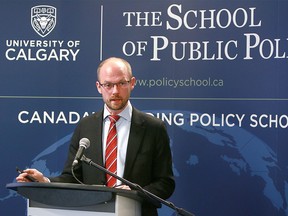
Albertans have climbed aboard the government’s royalty roller-coaster so many times in the past two decades that we’re used to being turned upside down by the boom-and-bust nature of oil and gas revenues.
Premier Danielle Smith says she wants to end that ride by building up the Alberta Heritage Savings Trust Fund.
In a televised state of the province address on Wednesday night, Smith set out her target to grow the fund from less than $25 billion in value today to something much, much larger.
By year’s end, the UCP government will unveil a long-term financial plan, “charting a path to a Heritage Fund of between $250 and $400 billion by the year 2050,” she said.
The government will also limit government spending increases below the legislated cap of inflation plus population, which could have major implications for next week’s provincial budget and the years ahead.
“Instead of spending all that non-renewable surplus cash on the wants of today, we will instead be fiscally disciplined, invest in the Heritage Fund annually . . . and slowly but surely wean our province’s budget off the volatile roller-coaster of resource revenues,” Smith said.
“In my view, our province has one last shot at getting this right.”
While the path to socking away more money in the province’s rainy-day account is unclear, it appears the focus in next week’s budget will be on saving and paying down debt, not major spending increases.
A promise that Smith made during last year’s election campaign of a personal income tax cut “will have to wait a year and be phased in responsibly,” she said.
Last May, the UCP vowed to create a new eight per cent tax bracket on income under $60,000 annually — people making above that rate would save up to $760 a year — at a price tag of $1 billion annually to the provincial coffers.
Smith said even with economists predicting softer oil and gas prices in the coming year, spending cuts will not be needed to balance the books in the new budget year. However, weaker resource revenues will require “more restraint than previously predicted,” she added.
The provincial budget is set to be released on Feb. 29.
-
 2022: Varcoe: Another fumble on Heritage Fund adds to ‘Alberta’s single-greatest missed opportunity’
2022: Varcoe: Another fumble on Heritage Fund adds to ‘Alberta’s single-greatest missed opportunity’ -
 2023: Option of keeping more cash in Alberta Heritage Savings Trust Fund ‘in the works’
2023: Option of keeping more cash in Alberta Heritage Savings Trust Fund ‘in the works’ -
 Alberta’s projected 2023-24 surplus more than doubles to $5.5B
Alberta’s projected 2023-24 surplus more than doubles to $5.5B
On Tuesday, the NDP predicted the document will include broken promises by the UCP government. And with a population boom underway, pressure continues to build on public services.
“Their failure to plan for rising costs and an increase in population means not only will this budget not be able to keep up, it’s going to further exacerbate the problems we’re seeing with affordability in our crumbling health-care system,” NDP MLA Samir Kayande told reporters.
“People rely on these essential public goods, and our need for them doesn’t go away just because the UCP shrinks a line item.”
Previous Alberta governments of different political stripes have vowed to get the province off the royalty roller-coaster and build up the Heritage Fund, with limited success.
Meanwhile, Norway’s sovereign wealth fund, which was set up after the discovery of oil in the North Sea, saw its first deposit from the government made in 1996. It now holds more than US$1.6 trillion of assets.
The Heritage Fund was created under then-premier Peter Lougheed in 1976, initially designed to receive up to 30 per cent of non-renewable resource revenues.
Yet, as oil prices weakened by the early 1980s, income was shifted back into the province’s general revenue fund for day-to-day government spending. By 1987, the regular royalty transfers to the fund ended.
By last March, more than $42 billion of investment income had been transferred from the fund to the government. Another $3.5 billion was directed to capital projects spending, according to the latest Alberta Heritage Savings Fund annual report.
After the premier’s address, University of Calgary economist Trevor Tombe said he was struck by the unambiguous language from Smith about shifting Alberta away from its dependence on spending oil and gas revenues each year.
While former premier Jim Prentice in 2015 strived to make a shift, the PC leader was heading into an election — one he lost to the NDP — while Smith is early in her mandate, he noted.
To reach the premier’s goal, Tombe said it will require Alberta to save a “meaningful share” of budget surpluses that currently flow into the Alberta Fund, in addition to retaining investment income within the rainy-day Heritage Fund.
“It is possible . . . We can, over a pretty reasonable timeframe, no longer be reliant on resource revenues, if we save enough of the surplus,” Tombe said.
“It is not too late to accumulate a very large Heritage Fund at this point.”
But it will require a firm commitment.

As a report by the University of Calgary’s School of Public Policy in 2018 aptly noted, provincial governments chose over the past five decades to let volatile energy prices create budget volatility.
“These outcomes are the result of the government failing to heed the advice of economists, namely, to save energy revenues,” said the report by Ron Kneebone and Margarita Wilkins.
“Getting off the energy roller-coaster requires new revenue, cuts to program spending, or some combination of the two.”
Smith noted that last year’s budget needed about $16 billion of non-renewable resource revenue to balance Alberta’s $70 billion financial blueprint.
The province still had a “few billion left over” to pay down debt and to put $3 billion of surplus and investment income into the Heritage Fund, which had $21.4 billion of assets at the end of September.
During a 13-year span, the province ran 12 budget deficits, beginning in 2008-09. It posted record red ink of almost $17 billion in 2020-21, when resource revenues collapsed during the first year of the pandemic to just $3 billion.
But in the last fiscal year, resource revenues jumped to $25.2 billion, while the budget surplus ballooned to $11.6 billion.
Smith said it’s time to establish a long-term financial plan that allows Alberta to balance its budget each year with stable revenues to fund core government services.
“We need to correct course now while we still have time. Bluntly stated, our province has become unsustainably dependent on non-renewable resource revenues,” she said.
The premier flatly rejected the notion of raising income taxes or adopting a provincial sales tax.
Even with an energy transition ongoing, Smith said the province still has several decades ahead when countries will need Alberta’s resources. She believes the province is on the cusp of a prolonged resource boom.
“Now is not the time for us to bemoan what might have been,” Smith added.
“In my view, the time has come to act decisively and end any further procrastination.”
Chris Varcoe is a Calgary Herald columnist.
You can read more of the news on source



